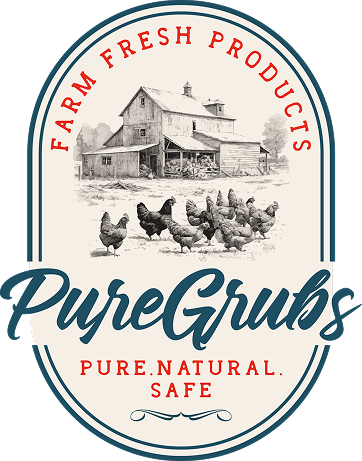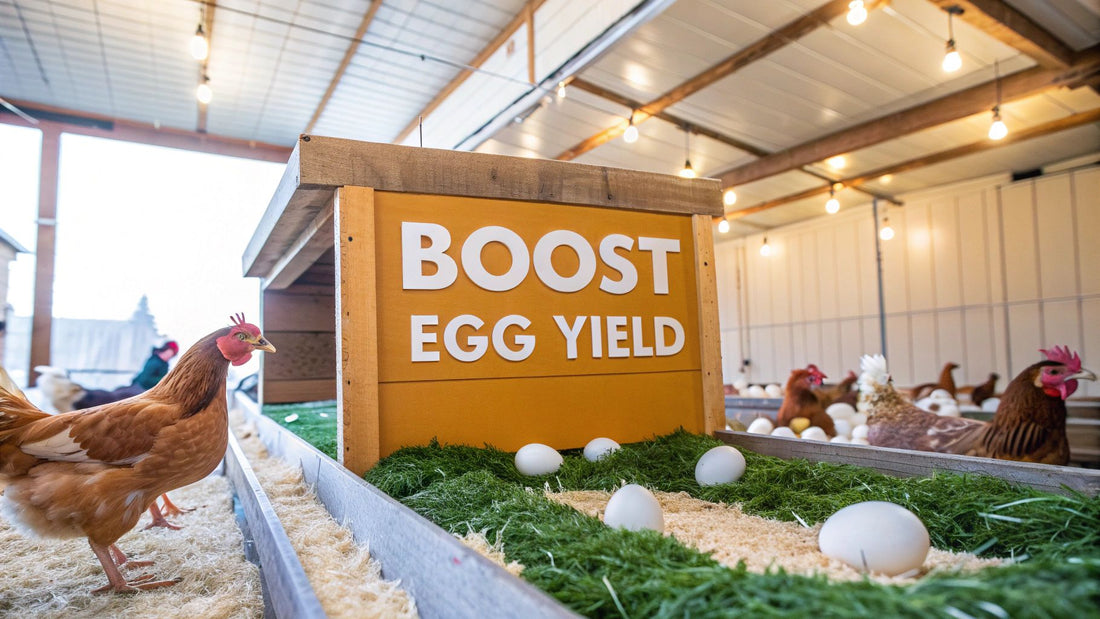
How to Increase Chicken Egg Production
Share
Boosting egg production really comes down to mastering four key areas: premium nutrition, optimized lighting, a low-stress coop, and proactive health management. When you get these fundamentals right, you give your flock the consistent support they need to be fantastic layers. This guide will walk you through how small, simple adjustments can lead to a basket brimming with eggs.
Your Foundation for More Eggs
Every chicken keeper knows the joy of finding a basket full of fresh eggs. But getting there isn't about some secret trick—it's about building a solid foundation of care that supports a hen's natural laying cycle.
Think of it as a partnership. When you give your hens everything they need to feel safe, healthy, and well-fed, they'll reward you with consistent, beautiful eggs. This means looking at their entire daily experience, not just their feed and water.
The link between a hen's comfort and her ability to lay is incredibly direct. Little changes can make a huge difference. For instance, a hen stressed by an overcrowded or dirty coop will use her energy for survival, not for laying eggs. Similarly, a diet that’s short on protein or calcium forces her body to choose between her own health and producing an egg. To get a deeper understanding of dietary needs, you can check out our guide on the best calcium supplements for chickens.
Setting Realistic Expectations
Before we jump into strategies, it's crucial to know what to expect. A few key factors that are out of your control will always influence how many eggs you get:
- Breed: High-production breeds like Golden Comets and White Leghorns are bred to lay over 300 eggs a year. In contrast, many heritage breeds will give you closer to 200-250.
- Age: Hens are at their absolute peak between 6 and 18 months old. After that, their output will naturally taper off a bit each year.
- Season: Those shorter daylight hours in fall and winter are a natural signal for a hen's body to rest. This often causes a slowdown or even a complete pause in laying until spring.
This natural cycle isn't just something we see in backyard flocks. On a commercial scale, even tiny shifts in the number of laying hens can have a massive impact on the national egg supply. A mere 1% change in the U.S. layer flock can swing the annual egg production by hundreds of millions. It just goes to show how directly flock health is tied to output. You can always see these trends reflected in the latest USDA reports.
Optimizing Nutrition for Peak Laying Performance
Think of your hen's diet as the fuel for her internal egg factory. If you put in low-grade fuel, you can't expect high-performance output. It’s that simple. The single most crucial part of their diet is a high-quality layer feed specifically formulated with 16-18% protein. This isn't just a suggestion; it's the non-negotiable foundation for consistent egg laying.
Many flock owners make the mistake of grabbing any bag of chicken feed, but a chick starter or grower feed just won't cut it. They simply lack the specific nutritional profile a working hen needs. Without that precise protein balance, your hens will struggle, and you'll see it reflected in a dwindling egg count.
The Critical Role of Calcium
Once you've got the protein nailed down, it's time to focus on calcium. A hen's body goes through an incredible process every 24 to 26 hours to form a hard, protective eggshell. This process demands a massive amount of calcium. If she can't get enough from her food, her body will start pulling it from her own bones, which can lead to brittle bones, weak shells, or even shell-less "rubber" eggs.
The solution is simple: offer a free-choice calcium source in a separate dish. Crushed oyster shell is the gold standard here. Hens have a brilliant natural instinct and will only take as much as they need.
Providing free-choice oyster shell lets your hens regulate their own calcium intake. It’s a much safer and more effective method than trying to mix calcium into their main feed. This one small step is a game-changer for shell quality.
Boosting Protein With High-Value Supplements
While a solid layer feed is the bedrock of their diet, certain supplements can really elevate their production, especially during stressful times like a molt or a cold snap. High-protein treats give them the extra energy and amino acids needed to regrow feathers and keep laying eggs.
This is where supplements like Black Soldier Fly Larvae (BSFL) come into play. Chickens are natural foragers, and they go absolutely wild for insects. BSFL offers a powerful, concentrated punch of protein and other goodies.
- Pure Grubs BSFL: These are a fantastic choice, providing a natural protein boost that chickens instinctively crave.
- Essential Fats: The healthy fats in BSFL contribute to a hen's overall vitality and can even lead to richer, more nutritious yolks.
- Encourages Natural Behavior: Tossing a handful of grubs into their run gets them scratching and pecking, which is a great way to fight boredom and stress in the coop.
Truly understanding what to feed laying hens is the key to a full egg basket. For a deeper dive into crafting the perfect diet, our detailed guide has you covered.
Don't Forget The Water
Finally, let's talk about the most overlooked nutrient: water. An egg is roughly 75% water. If a hen goes without fresh, clean water for even a few hours, her internal system can shut down egg production immediately. It can then take days—sometimes weeks—for her to get back into her regular laying rhythm. Always make sure their waterers are full, clean, and easily accessible, especially on hot days.
The right nutrition doesn't have to be complicated. As you can see below, a bowl of high-quality layer feed paired with a side of oyster shell sets the stage for success.
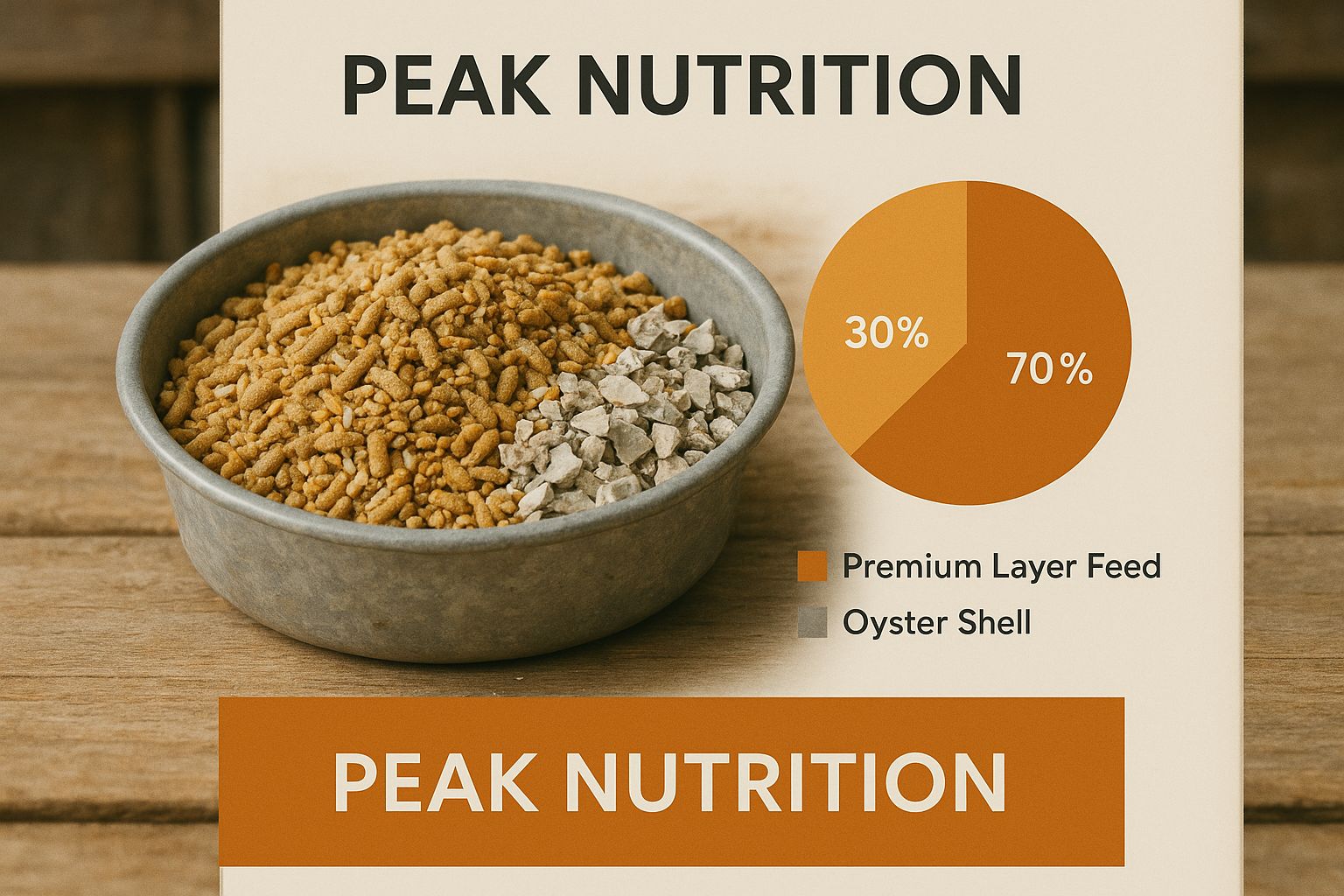
This simple combination forms the cornerstone of any effective strategy to boost your flock's egg production.
Layer Feed and Supplement Comparison
Choosing the right feed and supplements can feel overwhelming, but breaking it down by function makes it much clearer. This table compares the essentials to help you build the perfect nutritional plan for your layers.
| Nutrient/Supplement | Optimal Level for Layers | Primary Function | Common Sources |
|---|---|---|---|
| Protein | 16-18% of total feed | Egg formation, feather growth, overall health | Commercial layer pellets/crumbles, BSFL, mealworms |
| Calcium | 3.5-5% | Eggshell formation, bone health | Crushed oyster shell, limestone grit, aragonite |
| Probiotics | Varies by product | Gut health, nutrient absorption, immune support | Fermented feeds, yogurt, commercial probiotic powders |
| Grit | Free-choice access | Grinds food in the gizzard for proper digestion | Insoluble granite grit, cherry stone grit |
| Water | Constant access | Hydration, nutrient transport, egg composition | Fresh, clean water changed daily |
Ultimately, a balanced diet combining a complete layer feed with key free-choice supplements like oyster shell and grit provides the robust nutritional foundation your hens need to be happy, healthy, and productive layers.
Keep the Eggs Coming Year-Round with Smart Lighting
A hen's entire world revolves around the sun. When the days start getting shorter in the fall, her body gets a clear signal: it's time to take a break from laying and save up energy for the winter. It’s a completely natural, hard-wired instinct. But if you want a steady supply of eggs all year long, you can step in and become the sun, at least for a few hours.
By managing the light in your coop, you're essentially recreating the long, bright days of spring and summer that tell a hen's body it's the perfect time to be productive.
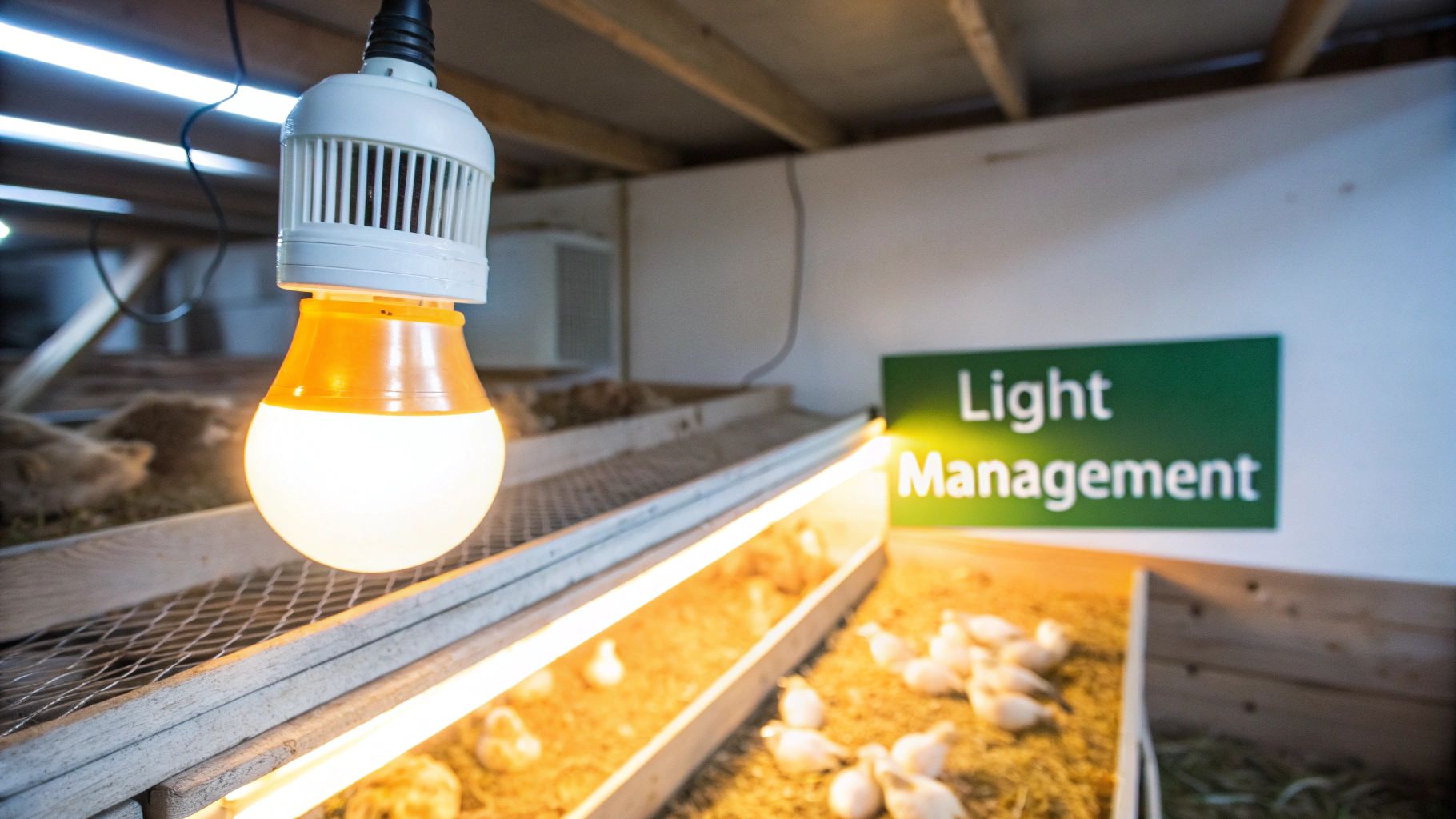
This whole process works by influencing the hen's pituitary gland. Think of it as the mission control for egg production. When this gland senses long days, it sends out the hormones that get the reproductive system fired up. A little bit of extra light keeps that system humming right through the darkest months of the year.
The Magic Number: 14 to 16 Hours of Light
So, what's the sweet spot? My experience and poultry science both point to the same range: 14 to 16 hours of light each day. Anything less than 14 hours usually isn't enough to kickstart the laying response. Push it past 16, and you risk stressing your birds out, which is a surefire way to hurt production in the long run.
One of the biggest mistakes I see people make is just leaving a light on 24/7. This is incredibly disruptive to a hen's natural rhythm. They need that downtime.
Constant light can cause a whole flock of problems:
- Burnout and Stress: Just like us, chickens need their sleep. A period of darkness is crucial for them to rest properly.
- Bad Behavior: Overstimulated, tired chickens get cranky. This often leads to more pecking and aggression within the flock.
- Worn-Out Hens: A hen that never gets a break will eventually decline in health, and her laying days will be numbered.
My Pro Tip: Don't think of the light as a replacement for the sun, but as an extension of it. I’ve found the best way to do this is by adding light in the early morning hours. That way, when evening comes, the transition to darkness is natural as the sun sets, rather than plunging them into a sudden blackout when a timer clicks off.
A Simple and Safe Lighting Setup
You don’t need a fancy or expensive system to make this work. For most backyard coops, a single, low-wattage LED bulb does the trick perfectly. I prefer a "warm white" bulb (around 2700K) because it has a softer, more natural glow that isn't as harsh as the bright, cool-toned lights.
The key to consistency is automation. Grab a simple outlet timer from any hardware store and plug your light into it. Set it to turn on a few hours before sunrise to bridge the gap and hit that 14- to 16-hour goal.
For instance, if you're only getting 10 hours of natural daylight, set your timer to provide an extra four to six hours of light before the sun comes up. This simple, low-cost trick is one of the most effective ways to increase chicken egg production when the days get short.
Creating a Productive Coop Environment
A hen’s diet is fuel for the egg-making machine, but her surroundings can either supercharge it or shut it down completely. When a hen is stressed or uncomfortable, her body diverts all its energy toward survival, and egg production is one of the first things to go. If you want a steady supply of eggs, creating a calm, clean, and secure coop is one of the most powerful things you can do.
Think of the coop as their sanctuary. It’s where they sleep, feel safe from predators, and find that perfect private spot to lay. Overcrowding is a huge stressor that can bring egg-laying to a screeching halt, so giving them enough room to breathe is where it all starts.
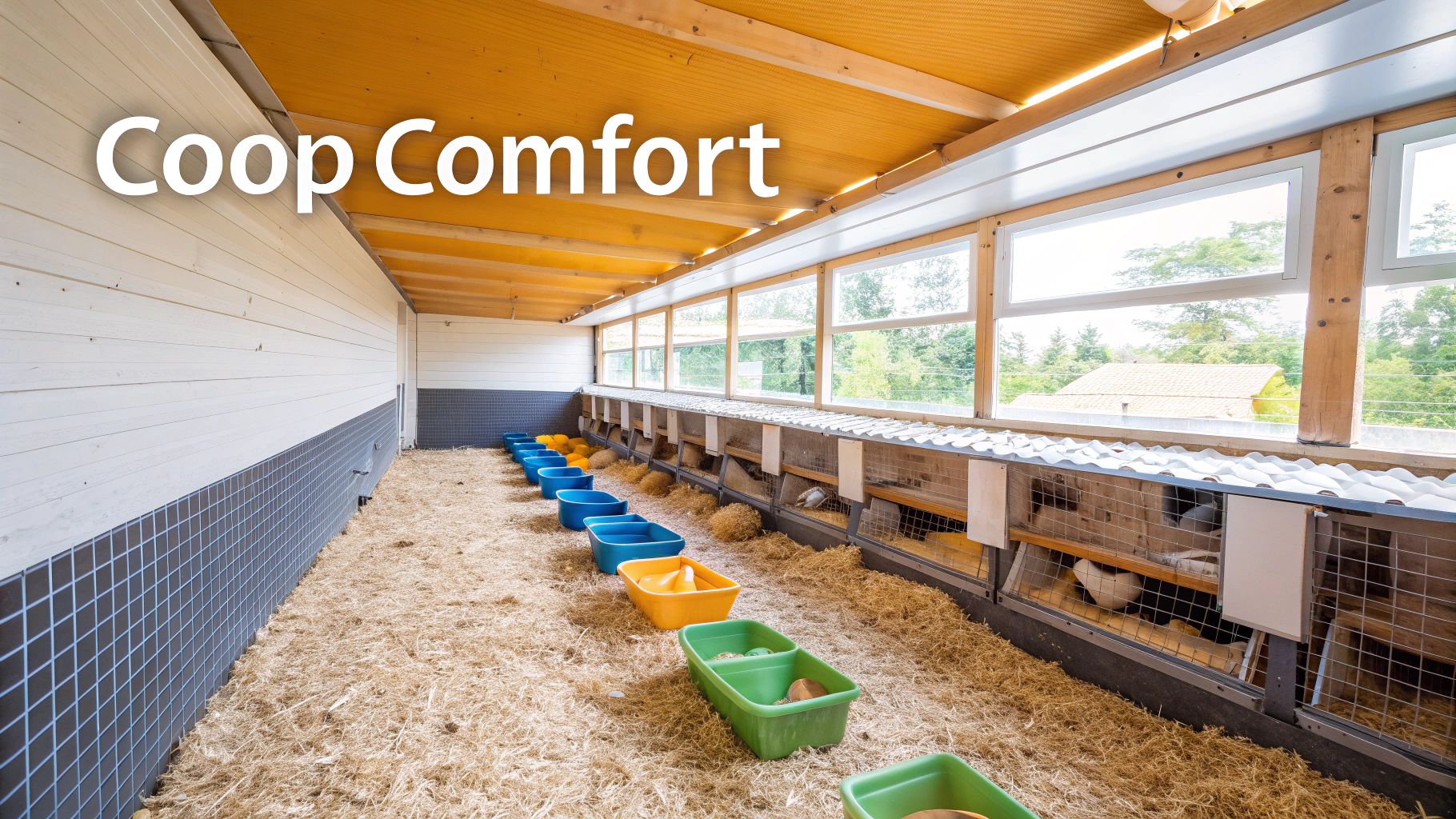
This isn’t just a secret for backyard keepers; it's the foundation of the entire global egg industry. Think about it: between 1995 and 2025, worldwide egg production more than doubled to a staggering 99 million tonnes each year. That kind of growth was only possible through massive improvements in biosecurity, health management, and creating optimized living conditions for millions of hens. If you're curious, you can discover more insights about the expanding global egg market and what's driving it.
Space and Bedding Essentials
A good starting point is to give each standard-sized hen at least 3-4 square feet of space inside the coop. Honestly, more is always better. This extra elbow room lets them move around freely, which cuts down on squabbles over the pecking order and lowers the overall stress level of the flock.
Clean, dry bedding is just as critical. When bedding gets damp and soiled, it becomes a breeding ground for nasty bacteria, parasites, and ammonia fumes that can wreck your chickens' respiratory systems. A nice, deep layer of pine shavings or straw not only keeps things clean but also gives the hens something to scratch and dust bathe in—activities that are essential for their well-being.
Nesting Boxes and Ventilation
Hens are hardwired to find a dark, private, and safe spot to lay their eggs. If the nesting boxes you provide are dirty, full of droppings, or right out in the open, don't be surprised when you start finding eggs on the coop floor or hidden in the yard.
Creating an inviting place for them to lay isn't complicated. Just stick to these basics:
- Provide Enough Boxes: A good ratio is one clean nesting box for every 4-5 hens.
- Keep Them Tidy: Line the boxes with fresh straw or shavings and swap it out whenever it gets soiled.
- Location, Location, Location: Tuck the boxes away in the darkest, quietest corner of the coop.
Finally, you can't overlook ventilation. Good airflow is essential for getting moisture and ammonia out of the coop without creating a chilly draft. Vents placed high up on the walls are perfect for letting stale, warm air escape while fresh air circulates, keeping your flock healthy year-round.
A well-ventilated coop that smells fresh when you walk in is a sign of a healthy environment. If you can smell ammonia, your ventilation isn't adequate, and it's time to add more vents near the roofline.
Keeping Your Flock Healthy and Stress-Free
A healthy, content hen is an egg-laying machine. But the moment a bird gets sick or stressed, her body hits the brakes on egg production. All her energy shifts from making eggs to simply surviving. This is why keeping your flock in top shape and maintaining a low-stress environment aren't just nice things to do—they're absolutely critical if you're serious about getting more eggs.
The best defense is a good offense. This starts with a quick, daily check-in with your birds. It doesn't have to be a formal veterinary exam; just spend a few minutes watching them. Are they active, scratching around, and being their usual busy selves? Are their eyes bright and clear? A hen huddled in a corner, showing a runny nose, or just seeming "off" is waving a red flag that something is wrong.
Catching problems like mites, lice, or the first sniffle of a respiratory illness before it rips through the entire coop can save you from a total shutdown in your egg supply. Early detection is your best friend.
Simple Biosecurity That Actually Works
"Biosecurity" sounds like a high-tech term, but for a backyard flock, it really just boils down to common sense. The single most important rule is to quarantine any new birds for at least 30 days before they meet your established flock. This gives you plenty of time to see if they're carrying any hidden illnesses.
Another easy win is to limit who goes into your coop and run. Have a dedicated pair of boots or shoes that you only wear around your chickens. This simple habit keeps you from accidentally tracking in diseases from who-knows-where.
Preventing a disease from ever reaching your flock is a thousand times easier than trying to treat it once it takes hold. That strict quarantine period for new birds? It’s the cornerstone of good flock management and keeping those egg baskets full.
Cutting Down on Flock Stressors
Chickens are creatures of habit, and they can be surprisingly sensitive. Anything that disrupts their daily routine or makes them feel unsafe can cause egg numbers to plummet. Pinpointing and minimizing these stressors is a huge part of the puzzle.
Here are the most common culprits I see:
- Predator Threats: Even the shadow of a hawk flying overhead or a raccoon rattling the coop door at night can put the entire flock on high alert. Double-check that your coop and run are buttoned up and secure.
- Flock Bullies: The pecking order is a real thing, but a relentless bully can make life miserable for the others. If you see one bird constantly harassing others, especially at the feeder, sometimes a "time out" in a separate space for a day or two can reset the dynamic.
- Overcrowding: Too little space at the feeder, waterer, or on the roosts creates a constant, stressful competition. The golden rule is to always provide more space than you think you need.
- Chaotic Routines: Your flock thrives on predictability. Try to let them out, feed them, and lock them up for the night at roughly the same time every day.
By actively looking after your flock's health and creating a calm, predictable home, you're building a solid foundation for consistent laying. A happy, healthy flock isn't just a joy to watch—it's also the most productive one.
Answering Your Top Questions About Egg Production
Even when you're doing everything right, questions are bound to pop up. Troubleshooting is just part of raising chickens, and knowing what to look for can save you a lot of worry. Let's dig into some of the most common questions flock owners have when they're trying to figure out how to increase chicken egg production.
Why Did My Chickens Suddenly Stop Laying Eggs?
It’s always a little jarring when the egg basket suddenly comes up empty, but don't panic. More often than not, it's a natural, temporary issue. The most common reason, especially as fall rolls in, is the annual molt. Hens need a massive amount of protein and energy to regrow a whole new set of feathers, and they simply can't spare any for egg-making during that time. It's a demanding process that brings production to a dead stop.
A few other usual suspects could be at play:
- Stress: Chickens are creatures of habit. A close call with a hawk, adding new birds to the flock, or even a big thunderstorm can throw them off their laying cycle.
- Illness: A sick hen is not a laying hen. If a bird seems lethargic, has ruffled feathers, or you notice a change in her droppings, she's likely using all her energy just to get well.
- Shorter Days: A hen's reproductive cycle is hardwired to sunlight. Once daylight dips below 14 hours a day, her body's internal clock tells her it's time to rest for the winter.
- A Dry Waterer: This is a big one. An empty waterer, even for just a few hours on a hot day, can shut down the egg factory almost instantly.
A quick walk-through to check on their health, coop security, feed, and water will usually lead you straight to the cause.
How Long Until I See More Eggs After Making Changes?
This really depends on what you're fixing. Some changes get you results almost overnight, while others require a bit more patience.
If the waterer was empty, you'll likely see eggs again within a day or two once they're rehydrated. But if you’ve switched to a higher-quality feed or added a new supplement, give it 2 to 4 weeks. Their bodies need time to adjust to the new nutritional profile before you see an uptick in laying. Similarly, if you add supplemental light to get them through the winter, you should expect to wait about a month for a noticeable difference.
The real secret is consistency. Give your flock time to respond to the positive changes you're making. Small, steady improvements always work better than sudden, drastic shifts in their routine.
Can I Give My Chickens Too Much Calcium?
Absolutely. It is possible to overdo it with calcium, which can cause kidney damage and other health issues. This is exactly why you should never mix extra calcium directly into their main feed. Any good layer feed is already formulated with the right amount for an average hen's needs.
The best practice is to offer supplemental calcium—like crushed oyster shells or even baked, crushed eggshells—in a separate dish. Let them take it free-choice. Chickens are surprisingly good at knowing what their bodies need. A hen will only eat as much extra calcium as she requires to build a strong eggshell that day. This approach ensures every bird gets what she needs without any risk of getting too much. You can dive deeper into this topic by learning more about how to improve egg quality with proper nutrition.
What Are the Best Breeds for High Egg Production?
If your main goal is a full egg basket, you simply can't go wrong with production hybrids. Breeds like Golden Comets, ISA Browns, and White Leghorns are egg-laying machines, specifically bred to shell out over 300 eggs a year.
For those of us who also love the charm and hardiness of heritage breeds, there are some fantastic layers to choose from. Rhode Island Reds, Sussex, Plymouth Rocks, and Australorps are all rock-solid choices. They're known for their consistent production—usually between 250 and 280 lovely brown eggs a year—and they also tend to be great foragers with wonderful personalities.
